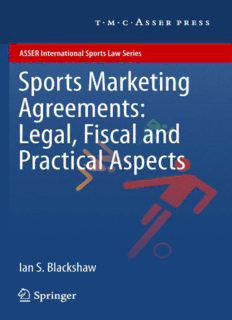
Sports Marketing Agreements: Legal, Fiscal and Practical Aspects PDF
Preview Sports Marketing Agreements: Legal, Fiscal and Practical Aspects
ASSER International Sports Law Series For furthervolumes: http://www.springer.com/series/8858 Ian S. Blackshaw Sports Marketing Agreements: Legal, Fiscal and Practical Aspects 123 Prof.IanS. Blackshaw 80ruePrincipale 62310Sains-les-Fressin France e-mail: [email protected] ISSN 1874-6926 ISBN 978-90-6704-792-0 e-ISBN978-90-6704-793-7 DOI 10.1007/978-90-6704-793-7 LibraryofCongressControlNumber:2011938391 (cid:2)T.M.C.ASSERPRESS,TheHague,TheNetherlands,andtheauthor2012 PublishedbyT.M.C.ASSERPRESS,TheHague,TheNetherlandswww.asserpress.nl ProducedanddistributedforT.M.C. ASSERPRESSbySpringer-VerlagBerlinHeidelberg Nopartofthisworkmaybereproduced,storedinaretrievalsystem,ortransmittedinanyformorby anymeans,electronic,mechanical,photocopying,microfilming,recordingorotherwise,withoutwritten permissionfromthePublisher,withtheexceptionofanymaterialsuppliedspecificallyforthepurpose ofbeingenteredandexecutedonacomputersystem,forexclusiveusebythepurchaserofthework. Theuseofgeneraldescriptivenames,registerednames,trademarks,etc.inthispublicationdoesnot imply, even in the absence of a specific statement, that such names are exempt from the relevant protectivelawsandregulationsandthereforefreeforgeneraluse. Coverdesign:eStudioCalamar,Berlin/Figueres Printedonacid-freepaper SpringerispartofSpringerScience+BusinessMedia(www.springer.com) Series Information BooksintheASSERInternationalSportsLawSerieschartandcommentuponthe legal and policy developments in European and international sports law. The books contain materials on interstate organisations and the international sports governingbodies,andwillserveascomprehensiveandrelevantreferencetoolsfor all those involved in the area on a professional basis. The Series is developed, edited and published by the ASSER International Sports Law Centre in The Hague. The Centre’s mission is to provide a centre of excellence in particular by providing high-quality research, services and products to the sporting world at large (sports ministries, international—intergovernmen- tal—organisations, sports associations and federations, the professional sports industry, etc.) on both a national and an international basis. The Centre is the co-founder and coordinator of the Hague International Sports Law Academy (HISLA), the purpose of which is the organisation of academic conferences and workshopsofinternationalexcellencewhichareheldinvariouspartsoftheworld. ApartfromtheSeries,theCentreeditsandpublishesTheInternationalSportsLaw Journal. Series Editors Dr. Robert C. R. Siekmann, Director Asser International Sports Centre e-mail: [email protected] Dr. Janwillem Soek e-mail: [email protected] M. A. van der Harst LL.M. e-mail: [email protected] Editorial Office ASSER International Sports Law Centre T.M.C. Asser Instituut P.O. Box 30461 2500 GL, The Hague The Netherlands www.sportslaw.nl Foreword I am pleased to write the Foreword to Professor Ian Blackshaw’s book on the Legal, Fiscal and Practical Aspects of Sports Marketing Agreements, particularly as various sports marketing methods and principles, as he points out in this book, inmanywaysoriginatedanddevelopedintheUnitedStates.Sportsmarketinghas nowtakenrootintherestoftheworldaswell,and,despitetheeconomicdownturn and recession, it continues to flourish. Inhisbook,ProfessorBlackshawadoptsanefficientandusefulapproachtothis subject by combining theory with practice. As shown in the Table of Contents, a wide range of sports marketing agreements are covered, including: Sports BroadcastingAgreements,oftenthelifebloodofamajorsportingevent;andNew Media Rights Agreements, which often provide sports marketers with an extra dimension for commercializing sports events particularly through online media such as ‘‘webcasting.’’ Of particular importance, the book covers the impact of the European Union (EU) on the commercialization of sports events, particularly the Competition Rules of the EU, which apply whenever sport constitutes an economic activity. As sport becomes a bigger and bigger business around the world it is difficult to conceive of any situation in which the necessary economic activity could be absent. As a result, the EU aspects of sports marketing are very important in practice and must be taken into account when negotiating and drafting sports marketing agreements with a European dimension. This book also tackles the important impact of tax law and rules on sports marketing. It specifically covers the fiscal aspects of Sports Image Rights Agreements and the need to shelter the considerable revenues that sports per- sonalities,suchasDavidBeckham,mayearnfromthecommercialexploitationof their image in a wide range of consumer goods and services on an international scale. Professor Blackshaw is a leading authority on the use of Alternative Dispute Resolution (ADR) for the extra-judicial settlement of sports disputes of various kinds, particularly commercial ones that transcend national boundaries. Demon- stratingthisexpertiseheincludesacomprehensivechapteronADRandextolsits vii viii Foreword merits for dealing with sports disputes that are bound to arise under a wide range of sports marketing agreements due to the large amounts of money involved and putatrisk.CoupledwiththisfocusonADR,throughoutthebookhereinforcesthe need to draft clear and unambiguous agreements as another method to avoid disputes. Overall, Professor Blackshaw’s book contains many useful insights and importantinformationregardingavarietyofsportsmarketingagreementsthatwill beofinteresttoreadersfromeveryaspectofthesportsindustry,including;sports administrators, rights holders, marketers, advertisers, broadcasters and their pro- fessionaladvisers,andotherswhoareinvolvedintheorganization,promotionand commercializationofsportseventsandpersonalities.Thisbookwillalsobecomea useful resource for academics, researchers, scholars and students in sports mar- keting and law. Congratulations to Professor Blackshaw on this important and highly practical book. I recommend this book to individuals involved in sports marketing and sports lawaroundthe world.Ilookforwardtorelyingonitinmyownsports law research and courses in the future. Milwaukee, Spring 2011 Prof. Paul Anderson Associate Director National Sports Law Institute Marquette University Law School Milwaukee, WI USA Author’s Preface Sport is now big business—worth more than 3% of world trade and 3.7% of the combinedGNPofthe27MemberStatesoftheEuropeanUnionwithapopulation ofsome500 million—andawholenewbodyoflawandpracticehasgrownupin the field of the commercialisation of sports events and the exploitation of the image and personality rights of elite athletes, all of which is commonly referred to—in the jargon—as Sports Marketing. Indeed,withouttheconsiderablerevenuesderivedfromvariousformsofSports Marketing, especially Sponsorship and Sports Broadcasting and New Media Rights—many major sporting events, such as the Olympic Games and the FIFA World Cup, could not be organised and staged; and likewise many athletes could not afford to train and participate in them—much to the disappointment of sports fans around the world. The aim of this book, therefore, is to provide sports administrators and their professional advisers, especially their lawyers, marketers, media advisers, adver- tising,PRandsportsagents,sportslawstudentsandresearchers,aswellasothers involved in the commercialisation, marketing and promotion of major sporting events and sports personalities, with an overview of the legal, fiscal and practical aspects of drafting and enforcing a wide range of standard Sports Marketing Agreements and also particular sports-specific clauses, including so-called ‘Morality Clauses’ in Sports Image Rights and Endorsement Agreements, partic- ularly relevant to the recent fall from grace of Tiger Woods and, indeed, of other sports personalities. The book also includes many samples of these Agreements, whose structures and contents are discussed, analysed and explained in the text of the relevant chapters. This special feature of the book will be of particular interest to legal practitioners, sports administrators, agents and managers. The book includes • many samples of these Agreements, whose structures and contents are dis- cussed,analysedandexplainedinthetextoftherelevantchapters. Thisspecial ix
Description: